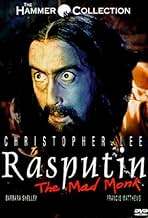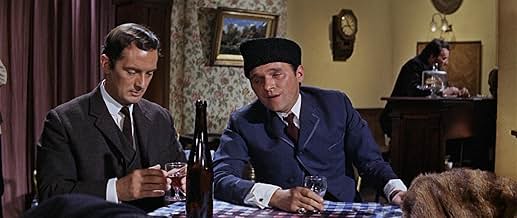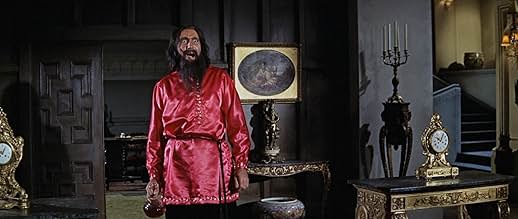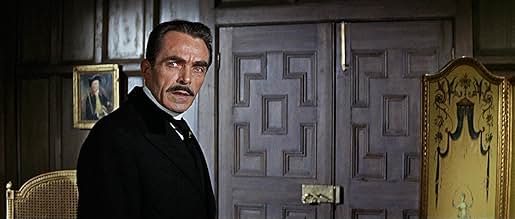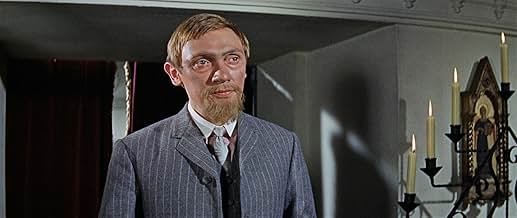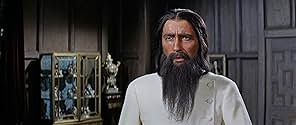अपनी भाषा में प्लॉट जोड़ेंThrown out of his monastery for licentious and drunken behavior, Rasputin travels to St Petersburg in pursuit of wealth and prestige. He soon gains influence at court with his powers of heal... सभी पढ़ेंThrown out of his monastery for licentious and drunken behavior, Rasputin travels to St Petersburg in pursuit of wealth and prestige. He soon gains influence at court with his powers of healing and of hypnotism.Thrown out of his monastery for licentious and drunken behavior, Rasputin travels to St Petersburg in pursuit of wealth and prestige. He soon gains influence at court with his powers of healing and of hypnotism.
- Alexandra, Tsarina
- (as Renee Asherson)
- Superior Lady
- (बिना क्रेडिट के)
- Michael
- (बिना क्रेडिट के)
- First Tart
- (बिना क्रेडिट के)
- Bar Patron
- (बिना क्रेडिट के)
फ़ीचर्ड समीक्षाएं
I have read reviews of those disappointed with this version and though I can not purport to have seen any of the others, may I suggest that perhaps familiarity with the subject matter thereby gained has bred some contempt for this version which may contain any number of historical inaccuracies. For I am sure that those uninitiated with the Rasputin tale - or who are at least willing to forgo their usual academic prejudice - and who delight in Hammer's 60s catalogue, will instantly warm to this film.
For those of you who don't know, Grigori Rasputin was a real-life Russian mystic/hypnotist/con-artist who had a heavy influence on the Tsarist government of Emperor Nicholas II and his wife Alexandra, after apparently healing their son Alexei as he lay dying from haemophilia. The film is less concerned with the politics of the time, and instead focuses on Rasputin's love for drinking, women, and generally being a bit of a bastard, as he hypnotises and heals his way through society and into the bed of lady-in-waiting Sonia (Barbara Shelley).
The film wastes no time introducing Rasputin's maverick attitudes to monkhood, as he heals a saloon owner's wife on her death bed so he can get served a drink, and proceeds to sing and drink the night way before hacking a man's hand off in a fight. Fleeing to Moscow after being hauled in front of the bishop for his unorthodox ways, he gains influence over a disgraced doctor and begins to plan his rise to power.
The film's main strength is undoubtedly Lee's performance as the mad Russian, as he dominates every scene with his intense, piercing eyes and booming voice, with his towering frame overshadowing everyone that comes across his path. The scene in which he does a celebratory dance after beating a challenger in a drinking contest only to mistake some onlookers for laughing at him is both weird and intimidating as he demands an apology. It is a great mix of thespian presence and Gothic camp that makes the Hammer films, and more notably Christopher Lee's performances for the studio, that extra bit special.
Rasputin The Mad Monk is a thoroughly enjoyable film, anchored by Lee's performance and Hammer's usual beautiful Technicolour cinematography, and is made all the better by leaving out the politics and concentrating on creating a memorable film character.
www.the-wrath-of-blog.blogspot.com
Lee is allowed the chance to really cut loose for once, and he does a marvelous job of going over the top as the lusty, life-of-the-party Rasputin, who has genuine healing abilities but also a very conniving and self-serving nature. After gaining some attention for curing a sick woman, he soon finds a means of manipulating his way into the royal family of early 20th century Czarist Russia. Naturally, there are those who aren't fooled by him and will seek to destroy him once they have the chance.
The Hammer studio does an immaculate job, as always, in recreating the sights and sounds of a period piece. Top talents such as production designer Bernard Robinson and (supervising) editor James Needs are at the top of their game. Don Banks composed the very unsubtle, thunderous music score, which does come in handy when Rasputin is required to make an entrance.
The excellent cast includes beautiful Barbara Shelley and Suzan Farmer, Francis Matthews, Dinsdale Landen, Renee Asherson, Derek Francis, and Joss Ackland; other than Lee, the performer that really stands out is Richard Pasco as Dr. Bruno Zargo, an alcoholic who becomes putty in the hands of the mad Rasputin. Lee himself is a delight, his rich voice booming with authority. He simply commands the screen, and keeps the right insane, evil glint in his eyes at all times.
The most entertaining of all the scenes is one in which a furious Landen unthinkingly rushes into a confrontation with Lee only to find himself outmatched. The final battle is an exciting one, with Rasputin proving to be exceedingly difficult to finish off.
Overall, this isn't top drawer Hammer, but it's still quite enjoyable, and worth a viewing for fans of the studio and star.
Seven out of 10.
Title (Brazil): "Rasputin: O Monge Louco" ("Rasputin, The Mad Monk")
क्या आपको पता है
- ट्रिवियाFilmed back-to-back with "Dracula, Prince of Darkness (1966)," using many of the same cast members and sets.
- गूफ़Although the Russians cross themselves correctly (right to left), the crucifixes and crosses are almost all Western rather than Orthodox, and there is an unbearded priest.
- भाव
Grigori Rasputin: When I go to confession I don't offer God small sins, petty squabbles, jealousies... I offer him sins worth forgiving!
- इसके अलावा अन्य वर्जनThe UK cinema version was cut by the BBFC to remove shots of a man's acid-scarred face and to shorten the love scene between Rasputin and Sonia, and VHS releases featured the same cut print. The cuts were restored in the 2003 Warner DVD and all subsequent releases.
- कनेक्शनFeatured in The Reptile (1966)
टॉप पसंद
- How long is Rasputin: The Mad Monk?Alexa द्वारा संचालित
विवरण
- चलने की अवधि1 घंटा 31 मिनट
- पक्ष अनुपात
- 2.55 : 1(original negative)
इस पेज में योगदान दें



